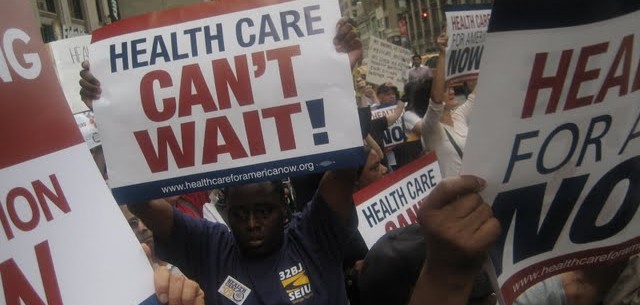Autumn has arrived, and in Washington that means two things: budget deals, and election campaigns. This year, there are no federal elections, so tax and spending measures claim the spotlight alone.
Congress passed a Joint Budget Resolution last spring which serves as an overall blueprint to guide specific committees of jurisdiction as they craft specific appropriations bills which (theoretically) adhere to it. Their Resolution called for large cuts in spending on Medicare, Medicaid, and the Child Health Insurance Program (CHIP) over the next decade (along with implicit suggestions of block granting or imposition of “per capita caps” for the latter two programs), and outright repeal of the Affordable Care Act (ACA) per special “budget reconciliation” instructions (see below.)
While only a simple majority was needed for adopting their Resolution and the President played no role concerning it, this time around with appropriations bills in play, both the Senate Minority Democrats and the White House will need to be included in whatever is finally enacted. In addition, the issue of funding for family planning services, particularly those provided through Planned Parenthood and/or state Medicaid programs, has since been added to the mix. Technically, all appropriations bills were to have been enacted by October 1st when the federal government’s new fiscal year began. However, as has often been the case in the past decade or more, this deadline was not met, and instead Congress enacted a “continuing resolution” (CR) to keep the government open and operating per the current budget for a limited period of time, this year until Dec. 11.
Outside of this regular budget matter, several other major actions that relate in various ways and in varying degrees will also need to be addressed and may likely end up as part of some “grand deal” by the end of this year. They include whether or not to reinstitute and/or refashion an across-the-board sequester of funds (50% defense, 50% discretionary domestic), raising the debt ceiling, renewing and refunding the transportation trust fund, continuing certain temporary tax provisions that benefit large corporations and/or low-income families, creating incentives for multi-national corporations to “repatriate” their profits booked off-shore, and whether or not to actually invoke the budget reconciliation process per se or forego it. In the end, the final decisions on all of these matters will be a function of both policy and political concerns, with an eye toward each party setting themselves up for next year’s elections when a new President and Congress will be chosen.
Overall, the Obama administration and Congressional Democrats are striving to cancel the budget sequester and minimize any general cuts to health care and social programs, except where rational savings can be achieved (e.g., lowering drug costs for public programs.) While the Budget Control Act of 2011 (enacted as a result of that summer’s fight over raising the debt ceiling) created the sequester process, it has only been invoked occasionally since then, and has been suspended for the past 2 years. Health care programs were largely exempted from it except for a 2% decrease in Medicare reimbursement rates to providers.
Congressional Republicans are seeking to reinstitute the sequester process in order to lower the overall deficit, and to rejigger its target areas to lessen the impact on defense spending and make up the difference via further cuts to domestic and social programs whose funding is discretionary (as opposed to mandatory.) (Mandatory programs, termed “entitlements” in federal budget-speak, are programs like Social Security, Medicare, Medicaid, CHIP, SNAP, SSI, veterans’ benefits, etc.) Should the sequester be reinstated, it is possible that Congress could revisit whether to institute new spending cuts in various health care programs in order to achieve overall deficit reduction target dollar amounts.
As for (yet another) repeal attempt of the ACA, using the budget reconciliation process would allow the Senate to bypass its normal rules for procedural votes where 60 votes are needed for cloture to move forward, thereby allowing simply 51-vote majorities to rule. However, this special process can only be used when the item under consideration is directly germane to spending, revenue raising, or deficit reduction, and related policy goals are of secondary concern. It cannot be used in the opposite circumstance where major policy change is attempted via relatively minor financial concerns, and when any measure actually raises the budget deficit.
Given these parameters, the ACA provisions considered at risk would be:
- the so-called individual and employer mandates (“responsibility’ provisions in ACA-speak)
- the medical device tax
- taxes on insurers’ windfall profits
- funding for the (yet to be created) Medicare Independent Payment Advisory Board
- the so-called “Cadillac” (excise) tax on employer-sponsored health plans with high actuarial values.
Left unaffected would be funding for:
- new health benefit exchange marketplaces;
- premium tax credits and cost-sharing reductions for low- and moderate-people who purchase private “qualified health plans”;
- expansions of Medicaid in states that have done so.
(N.B.: Source for information here about the ACA and budget reconciliation is from http://healthaffairs.org/blog/2015/10/21/instructions-for-reconciling-tax-credits-basic-health-plan-funding-methodology-released/)
Should these actions be taken in total, the Congressional Budget Office has estimated that the number of uninsured would rise by 14-15 million (20% of whom would be children), premium costs would rise by 20%, and up to 25% of current family planning patients could lose access to services. Should any or all of these changes and up in a budget bill that goes to the President, he is expected to veto them, so beyond policy considerations, Congressional leaders will also have to decide if they want to expend the time, energy, and political capital to pursue them since a successful veto override vote would likely be impossible.
Health care and social service advocates across New York State are mobilizing through the Restore the America Promise (RAP) campaign to:
- engage members of the House Majority (in the 2nd, 11th, 19th, 21st, 22nd, 23rd, 24th, and 27th congressional districts) about the importance of health care and social safety net programs to their constituents;
- engage members of the Congressional Progressive, Black, and Hispanic Caucuses, who have historically championed health care and social programs;
- engage Senators Schumer and Gillibrand to defend these programs as important to our state overall.
The RAP campaign is a statewide effort jointly spearheaded by Citizen Action of New York, Hunger Action Network of New York State, New York State AFL-CIO, the New York State Alliance for Retired Americans, New Yorkers for Fiscal Fairness, and New York Statewide Senior Action Council. Here in New York City, No Bad Grand Bargain, a network of labor and community activists, operates as the local affiliate for RAP, and we here at Metro New York Health Care for All coordinate its communications and convene its meetings.
Unexpectedly part of all this political stew is the unanticipated changes in House leadership now underway – how that all falls out and its impact on any final budget deal remains to be seen. At its most extreme would be a federal government shutdown over family planning funding for Planned Parenthood. However, speculation is that when all is said and done, a 2-year budget deal that’s not too far afield from the current status quo is likely to be negotiated, simply to get all parties past next year’s elections and into a new presidential administration and Congress when all these (and other) “major issues” will move back to the fore. In sum, elections do matter.
(P.S.: One other possible health care budget issue that’s suddenly emerged out of left field is fallout from a recently announced lack of any cost-of-living-adjustment (COLA) next year for Social Security beneficiaries. As a consequence, Medicare Part B premiums will skyrocket for a limited number of Medicare beneficiaries. A subsequent post to this blog will discuss that in more detail.)

